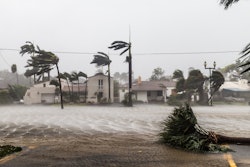
Over the years, executing a risk mitigation plan has transformed from something that’s nice to have to something that every company must have, at all times, in all facets of the organization.
From the influx of cargo theft, cybersecurity threats, food safety and driver shortage to geopolitical tensions, strikes from rail/dock workers, natural disasters and more, even the smallest gap can pose serious threat to people, product and plant.
Liken it to the blind leading the blind, getting lost in a maze or driving while blindfolded.
Not being able to see ahead and predict and plan accordingly is what sometimes plagues many of today’s supply chain companies.
That’s why mitigating supply chain threats is of utmost importance heading into 2024.
Marina Mayer, editor-in-chief of Food Logistics and Supply & Demand Chain Executive, talks exclusively with Ron Greene, VP of business development at Overhaul, outlines the rise in labor disruptions and cargo theft, and why companies need to double down on risk management in 2024.
CLICK HERE to read the article in full.
Food Logistics: What are some of the cold food chains biggest threats to date? And why?
Ron Greene: All logistics operations are similar with unique attributes; the threats to cold food chains and associated risks follow this same structure. A unique threat to one company’s logistics operations may be material and need to be mitigated, while the same threat to another company’s logistics operation may be trivial. For example, a food company operating in Mexico and Los Angeles need to take a proactive approach to mitigate theft, while the same company’s operations in Nebraska will likely not have to mitigate this specific risk.
Companies need to assess risks continually and make decisions on the appropriate mitigation approach as threats can change in real-time.
Below are some of the biggest threats to cold food chains:
Disruptions from external risks. Panama Canal, labor strikes, natural disasters – when these impact a company's logistics operations, it is costly as product will be delayed, possible spoilage issues, and lost sales. The rate at which major disruptions are increasing.
Inflation. Producing and moving food costs are increasing and being passed on to consumers. Price changes could change consumer purchasing patterns/demand.
Cyber risks. Cyber risks continue to increase, including ransomware, hacking, and other cyber-related scams.
Geoeconomic confrontation. Countries are increasingly using protectionist economic policies and state interventions in markets as mechanisms of self-sufficiency, leading to inefficiencies, price increases, and high inflation rates for companies.
Food Logistics: 2023 saw a lot of instability within the supply chain, such as geopolitical sanctions, natural disasters, inflation, etc. From your vantage point, how do these factors impact/influence the way companies can mitigate supply chain threats?
Greene: Companies are going to have to double down on risk management, including redundant suppliers and plans for increased levels of disruption.
Nearshoring is taking hold in the electronics industry for many of the same reasons; a more localized version (regional production facilities within the U.S.) may need to take hold in the food supply chain.
Food Logistics: According to multiple sources, the average value of cargo stolen during reported events in 2023 was $214,104, equivalent to an estimated $223 million in cargo across 1,778 reported theft incidents. What can be accredited to the rise in cargo theft?
Greene: Cargo criminals, both local (amateur) and organized (professional, often from out of state), are seeing more success than consequences (attributable to a decrease in priority for property crime in metro areas, which tend to be cargo theft hotspots) and are refining their methods and recruiting others.
Also, we know some cargo criminals are conducting cargo thefts from outside the country by infiltrating companies’ logistics systems as legitimate carriers and coordinating thefts.
Food Logistics: Labor disruptions are also substantially higher this year, up 136%, according to Resilinc data. This includes company and site-level strikes, national strikes, layoffs and labor protests, among others. What does this mean for the future of cold food supply chains?
Greene: Cold food supply chains will need to be more agile to avoid spontaneous chokepoints that arise in the supply chain.
Labor action, which will likely increase even further in 2024.
Inflation, global economic instability, the Ukraine/Russia conflict causing global food supply insecurity, the war in Israel draining global resources, and more potential wars on the horizon (China/Taiwan, NK/SK), etc).
Food Logistics: What are some things not addressed above that may be pertinent to our readers?
Greene: The supply chain risk management industry will continue to grow as the need to mitigate risks increases proactively. Technology and real-time tracking of temperature, locations, and overall status is proven to be an effective risk management layer for global supply chain operations.
CLICK HERE to read the article in full.



















